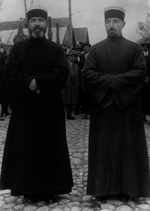The liturgy of the Karaims was made consistent at the end of the 13th century. This was worked out by a Karaim Aaron the Elder who lived between 1260 (?) -1320. He was a famous scholar, philosopher, theologist, exegesis scholar, poet, and a doctor. Aaron the Elder was born and lived at the town of Solkhat (now- Staryj Krym), and later on – in Constantinople. The prayer book edited by Aaron was first published in 1528-29 in Venice.

Vilnius Kenesa,
1996
The latest Karaim prayer book (compiled and edited by Mykolas Firkovičius) was published in 1998-99, in Vilnius, and consists of two volumes (the first one is destined to liturgy year cycle, the second one – to home ceremonies).
The liturgical process of the Karaim service depends on several factors: on the part of the day (either the eve or the morning), on the significance of the day (either an ordinary day of the week or Saturday), on the calendar occasion of the year. Every additional circumstance provides a specific input into the structure of the religious service, expands its core. From the point of view of content, the service consists of glorifying, thanksgiving, penance, beseeching, and the appeal prayers. Psalms and other Biblical texts base the texts of the prayers, only the solemn hymns are often created by known authors. The prayers are recited in the native Karaim language. The Karaims can pray both individually and in groups gathered in kenesa. It is recommended not to eat much or consume any alcohol before the prayer. The House of the Lord should be entered in an obedient and collected mood. The quality of the prayer does not depend upon the quantity of words, but upon the depth of emotions, piety and strong belief. The praying person is facing the South.

The highest priest, head of the Karaim Church, is hakhan who earlier was both the religious and the secular leader and chairman of the Spiritual Board. The Vice-Chairman of the Spiritual Board and the second highest-rank priest and Head of the Secretariat is the Senior Priest (ullu hazzan). Hazzan would be the priest that equivalents to the Roman Catholic parochial priest. His main function is to meet the spiritual needs of his community (djymat).
In 1927, in the town of Trakai, Khadji Seraya Khan Shapshal (1873-1961) was elected as hakhan. He was a famous orientalist, philologist, former Senior Crimean Karaim Priest. In the same year, the Lithuanian-Polish Karaim autocephaly community, preceding the hierarchical tradition of the Karaim Church of the Grand Duchy of Lithuania was proclaimed. In 1940, he was forced to resign and this post was not taken since that time. In 1992, the Karaim Community, as the successor of the Karaim religious community rights existing since the 14th century in Lithuania, was afforded the status of the legal person and was recognised as a traditional religious community of Lithuania.

